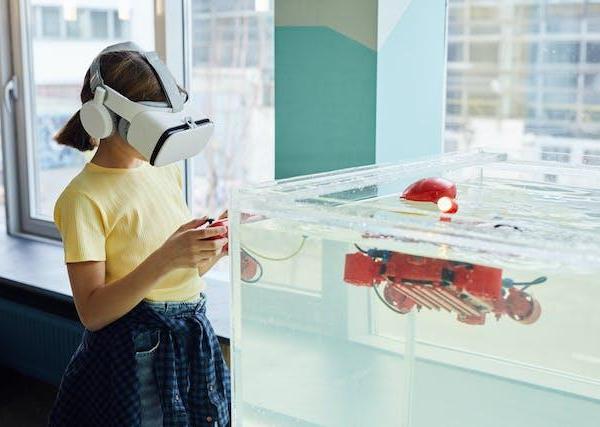Healthcare:
VR and AR have the potential to revolutionize healthcare by providing innovative solutions for diagnostics, treatment, and patient care.a. Medical Training: VR can simulate realistic medical scenarios, allowing healthcare professionals to practice procedures and surgical techniques in a safe and controlled environment. This immersive training can enhance skills, improve confidence, and reduce errors in real-life patient care.
b. Medical Visualization: AR can overlay medical images, such as CT scans or MRI scans, onto a patient's body, providing surgeons with real-time guidance during surgery. This technology can improve accuracy, reduce risks, and enhance surgical outcomes.
c. Rehabilitation: VR can be used for rehabilitation purposes, creating virtual environments that simulate real-life situations to help patients regain mobility, improve cognitive function, and manage pain. This technology provides a more engaging and motivating experience for patients.
Education:
VR and AR have the potential to transform the education sector by creating immersive and interactive learning experiences that enhance engagement and understanding.a. Virtual Field Trips: VR can transport students to different locations, historical periods, or environments, allowing them to explore and learn in a virtual setting. This technology provides access to experiences that may not be feasible in real life, enhancing understanding and engagement.
b. Simulations and Experiments: VR and AR can create realistic simulations and experiments, allowing students to practice skills, conduct experiments, and explore complex concepts in a safe and controlled environment. This technology enhances hands-on learning and promotes active engagement.
c. Accessibility: VR and AR can provide inclusive learning experiences for students with disabilities or those who have limited access to physical resources. These technologies can level the playing field, allowing all students to engage in immersive and interactive learning experiences.
Gaming and Entertainment:
VR and AR have already made significant strides in the gaming and entertainment industry, providing immersive and interactive experiences for users.a. Virtual Gaming: VR gaming creates an immersive and realistic gaming experience by transporting users to virtual worlds. This technology enhances immersion, engagement, and interactivity, providing a new level of entertainment for gamers.
b. Augmented Reality Games: AR games overlay digital elements onto the real world, creating interactive and engaging experiences. This technology blurs the line between the virtual and physical worlds, enhancing gameplay and providing new opportunities for social interaction.
c. Virtual Theme Parks and Experiences: VR and AR can enhance theme park experiences by creating virtual rides, interactive exhibits, and immersive storytelling. These technologies provide a new level of entertainment and engagement for visitors.
Retail:
VR and AR have the potential to transform the retail industry by providing immersive and personalized shopping experiences.a. Virtual Try-On: AR can allow customers to virtually try on clothing, accessories, or cosmetics, providing a more convenient and personalized shopping experience. This technology reduces the need for physical try-ons and enhances customer satisfaction.
b. Virtual Showrooms: VR can create virtual showrooms or stores, allowing customers to explore products, customize options, and make informed purchasing decisions. This technology provides a more interactive and engaging shopping experience.
c. Augmented Reality Advertising: AR can overlay digital content onto physical advertisements, creating interactive and immersive experiences for customers. This technology enhances engagement, brand awareness, and customer loyalty.
Manufacturing:
VR and AR have the potential to revolutionize the manufacturing industry by improving productivity, training, and quality control.a. Design and Prototyping: VR can create virtual prototypes, allowing designers and engineers to visualize and test products before they are physically built. This technology reduces costs, accelerates the design process, and improves product quality.
b. Assembly and Maintenance: AR can provide real-time guidance and instructions to assembly line workers or technicians, improving accuracy and efficiency. This technology reduces errors, enhances training, and improves productivity.
c. Quality Control: VR and AR can be used for quality control purposes, allowing inspectors to visualize and analyze products in a virtual environment. This technology improves accuracy, reduces inspection time, and enhances product quality.
Virtual reality and augmented reality have the potential to revolutionize various industries by providing immersive and interactive experiences that enhance learning, improve productivity, and transform experiences. In healthcare, these technologies can improve medical training, visualization, and rehabilitation. In education, they can create immersive and interactive learning experiences. In gaming and entertainment, they provide immersive and engaging experiences for users. In retail, they enhance shopping experiences and personalize customer interactions. In manufacturing, they improve design, training, and quality control processes. As these technologies continue to evolve and become more accessible, their potential in various industries is only expected to grow. It is an exciting time as we explore the possibilities and harness the power of VR and AR to reshape the way we live, learn, and work.



